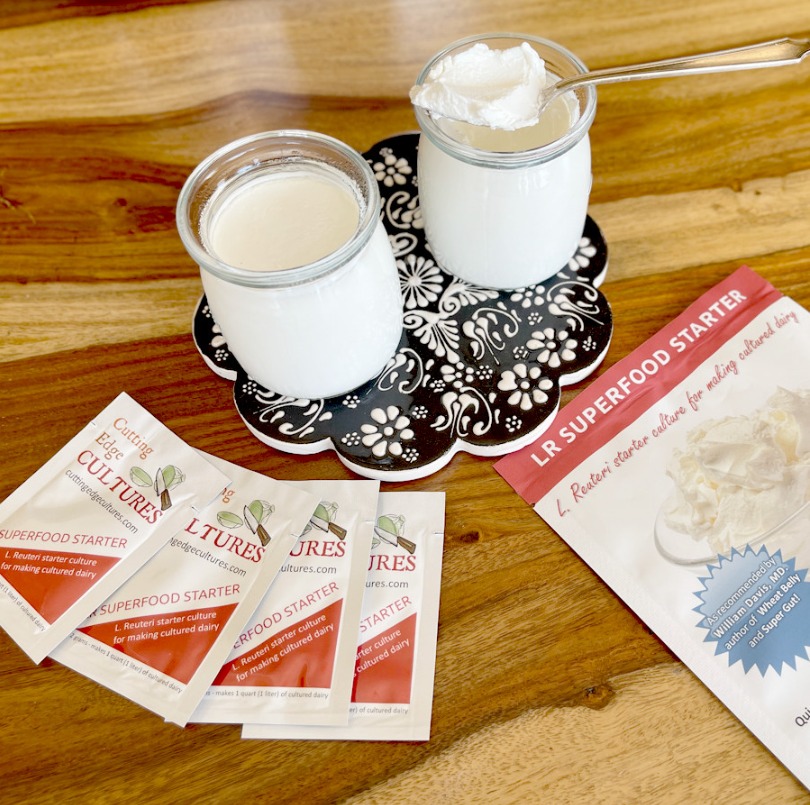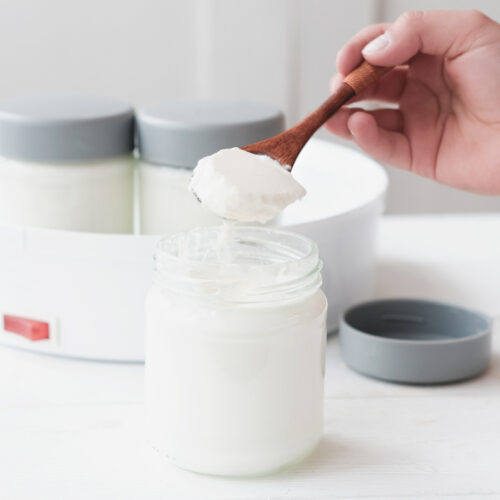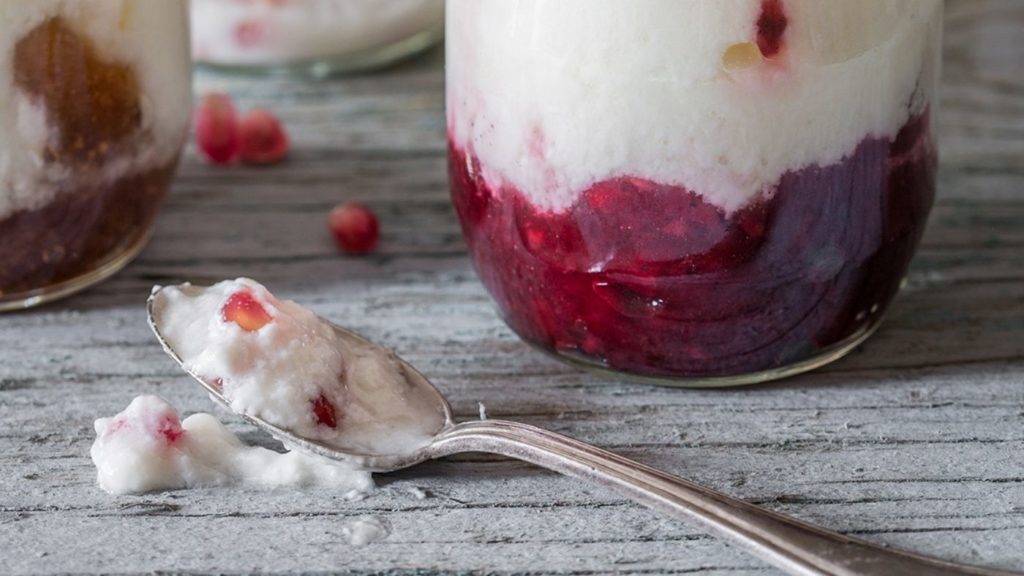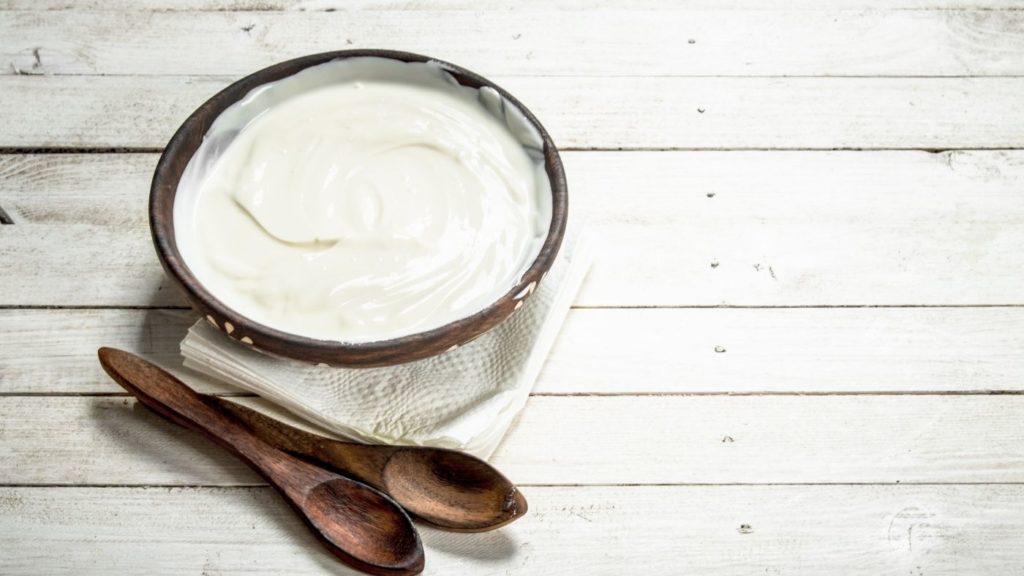Discover our L. reuteri yogurt recipe, a superfood popularized by Dr. William Davis and his best-selling book “Super Gut”. This yogurt is a real source of well-being, concentrating more probiotics than any other food supplement on the market.
With just milk, prebiotic fibre, and L. Reuteri Superfood Starter, make a powerful probiotic food, containing over 135 billion active probiotic bacteria per 250 ml (ref.).
This recipe gives you a step by step guide on how to prepare this yogurt, rich in Lactobacillus Reuteri, and how to incorporate it into your eating routine for the well-being of your health!
Go straight to the section that interests you:
- What is L. reuteri yogurt?
- How to make L. reuteri yogurt?
- L. reuteri yogurt recipe
- Storage and use
- Which milk to use?
- What appliance to use to keep the temperature constant?
What Is L. Reuteri Yogurt?
L. reuteri yogurt is a variant of traditional yogurt, enriched with probiotics thanks to the Lactobacillus Reuteri bacteria, a probiotic strain naturally present in the human intestine and with numerous benefits.
To produce Lactobacillus Reuteri yogurt, the bacteria are cultivated in milk or cream, to which prebiotic fibres are added to increase the number of probiotics tenfold.
This type of dairy product is often thicker and more acidic than conventional yogurt. In terms of health, the L. reuteri bacterium is known for its antimicrobial properties, capable of fighting incoming pathogens and boosting the microbiota’s immune system. This microorganism helps strengthen the intestinal barrier and reduce the absorption of certain microbes, which could prevent inflammatory diseases in the intestine and other areas of the body (ref.).

How To Make Reuteri Yogurt?
Making Lactobacillus Reuteri yogurt is simple: it requires few ingredients and offers great satisfaction.
In just 10 minutes of preparation and after 36 hours of incubation at a temperature of 35-37°C (95-100°F), you’ll have a tasty yogurt rich in probiotics and health benefits.
Follow these five essential steps:
- Mix the prebiotic fibres with the culture.
- Add milk.
- Cover with a lid.
- Incubate.
- Place in the fridge.
As incubation lasts 36 hours, it is advisable to start early in the morning, or late in the day.
It is common for the first preparations of L. reuteri yogurt not to reach the ideal texture, but with perseverance, by the third or fourth attempt, you should notice a marked improvement towards the desired consistency.

Lactobacillus Reuteri Yogurt Recipe
Equipment
- 1 appliance capable of maintaining a constant temperature of 37°C (100°F)
- 1 glass jar with lid, minimum 1 litre capacity
Ingredients
- 1 sachet LR Superfood Starter Culture
- 2 tablespoons prebiotic fibre
- 1 litre whole cow's milk (use dairy products without additives)
Steps
Mix the ingredients (inoculation)
- In the glass jar, mix the prebiotic fibres with the contents of one sachet of LR Superfood Starter.
- Add 250 ml (1 cup) of milk (cold or at room temperature).
- Whisk to remove lumps and ensure even distribution. Do not use a blender.
- Stir in the rest of the milk, leaving a few centimetres of space at the top of the jar. Mix or whisk to ensure even distribution. Do not mix in a blender.
- Put a lid on, leaving it slightly ajar, or use plastic wrap.
Incubation
- Place the jar in the incubator and ferment at 37°C (100°F) for 36 hours, away from drafts.
- Do not open the incubator or stir the jar during fermentation.
- After 36 hours, remove the jar from the incubator.
Storage
- Allow to cool to room temperature, then seal tightly and refrigerate.
- You can eat the yogurt after it has been refrigerated for a few hours.
Next Recipes
- Repeat these instructions but use 2 tablespoons of your prepared yogurt as a starter ferment. Don't forget the prebiotic fibre!
- If the previous yogurt has separated, use 1 tablespoon of the solid part and 1 tablespoon of the whey (or 2 tablespoons of whey if the solid part is too firm) as a starter ferment.
Notes
Storage and Use
Your L. reuteri yogurt can be kept in the fridge for up to 4 weeks.
There are several ways to consume your L. reuteri yogurt. The simplest way is to eat it like normal yogurt.
However, Lactobacillus Reuteri yogurt can also be used in recipes for:
- Dips and dressings
- Cheese
- Beverages and smoothies
- Desserts
- Ice cream…
Tip for Greek Yogurt: Drain the preparation for a few hours using a cotton bag to thicken the consistency.
Caution: Avoid vigorously mixing or heating L. reuteri yogurt; heat and intense mixing can destroy the beneficial probiotic cultures, thus reducing its health benefits.
Enjoy your L. reuteri yogurt in its pure form or as a secret ingredient in a multitude of recipes. What’s your favourite way to add it to your diet?
Frequently Asked Questions
Which Milk to Use?
Choose whole or semi-skimmed milk for a rich, creamy texture. Avoid skimmed milk (too liquid), raw milk (risk of unwanted bacteria), lactose-free milk (lack of nutrients for cultures), and pure cream (consistency too thick). Goat’s milk is a possible alternative, but the yogurt will be thinner.
For plant-based alternatives, coconut milk is preferable due to its fat content, but conventional plant milks are not ideal for this culture.
Don’t hesitate to add cream to your milk for a smoother consistency.
Which Appliance to Use to Keep the Temperature Constant?
To maintain a constant temperature of 35-37°C (100°F) for 36 hours, you can use:
- A sous-vide cooking appliance
- A yogurt maker with an adjustable thermostat
- A dehydrator
- An Instant Pot type programmable pressure cooker
- A slow cooker
The important thing is that your container can maintain the right temperature during the 36 hours of incubation. We recommend that you test your appliance for several hours before making your first recipe.
You should also make sure that the appliance you choose can easily accommodate your fermentation jar to ensure even heat distribution.
Why Use Prebiotic Fibres?
The use of prebiotic fibres is essential in the preparation of L. reuteri yogurt, as they act as a nutrient substrate, feeding the probiotic culture. This specific ‘fuel’ helps the bacteria grow vigorously, resulting in more active fermentation and a rich, creamy yogurt texture. What’s more, this fibre promotes a beneficial symbiosis in the intestinal microbiota when yogurt is consumed.
Prebiotic fibres can be purchased online and used in other fermentations (milk kefir, yogurt, kimchi, etc.) to promote the growth of beneficial bacteria.
What Are the Health Benefits of L. reuteri?
The Lactobacillus Reuteri strain is recognized for its many health benefits, supported by various scientific studies.
Lactobacillus Reuteri may be able to support (ref.):
- A healthy microbiome
- The immune function
- Cellular health
- A healthy intestinal barrier
- Digestive health
L. reuteri plays an impressive role in eliminating infections and mitigating gastrointestinal disease, as well as disease in distant tissues (ref.).
More specifically, L. reuteri has shown antifungal properties against five of the six most common Candida species, making this probiotic a major ally in the fight against SIBO (small intestinal bacterial overgrowth). It has completely eliminated these species and is now being studied as a treatment for SIFO (intestinal fungal overgrowth). SIFO is characterized by the presence of an excessive number of fungal organisms in the small intestine, associated with gastrointestinal symptoms (ref.).
My Yogurt Has Separated and Is Grainy!
Yogurt separating into solid and liquid parts is normal and not a sign of failure! You can simply mix them together to make the yogurt smoother.
Separation is a common phenomenon, reflecting dynamic, prolonged fermentation and the activity and health of the culture. Unlike industrial yogurts, homogenized by stabilizers, L. Reuteri yogurt is natural, with no additives.
My Yogurts Are Becoming Increasingly Acidic
The more you use your previous yogurts to backslope your next ones, the more acidic they become over time. Cut the acidity by eating it with sweet ingredients or start a new fermentation by using a new sachet of culture.
My Culture Fermented at Over 37°C, Is It Dead?
A few degrees more or less shouldn’t make much difference. However, if your temperature has risen above 40°C, your culture may have died. To check this, start a new fermentation and observe the results.
The Surface of My Yogurt Is Pink/White!
This colour usually indicates harmless yeast that has appeared as a result of exposure to air or poorly distributed ingredients. Remove the affected surface; if the rest has a tangy taste without bitterness, it’s safe to eat.
To make sure it doesn’t happen again, it’s best to restart a recipe with a new sachet of culture and sanitize your entire equipment.

